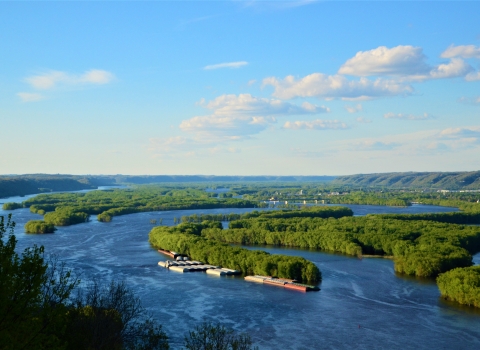Conserving wildlife and inspiring others to do the same drives our small but dedicated staff at Parker River National Wildlife Refuge. Each year, we welcome over 300,000 visitors from near and far to explore boardwalks and trails, glimpse once-in-a-lifetime birds, and marvel at the scenic beauty of the Great Marsh. This includes more than 30,000 visitors who participate in our extensive free nature programming, from school field trips to cranberry bog tours to star gazing parties. Our goals are simple: to benefit both people and wildlife as stewards of this unique and beautiful landscape. Along with partners, we have been nationally recognized for outstanding restoration efforts improving salt marsh salt marsh
Salt marshes are found in tidal areas near the coast, where freshwater mixes with saltwater.
Learn more about salt marsh health and climate resiliency to protect Plum Island for future generations. This community is dear to us, and we know that even when we disagree, we share many of the same values.
We understand that for many in our community, the decision to remove the Pink House from its present site is an unpopular one. Over the past eight years, our team has worked to identify an alternate solution in partnership with regional and national offices, local, state, and federal elected officials, and community members. Yet, in the continued absence of a legally viable solution, we have to act in the best interest of our conservation mission. Increasing storm severity, extreme tides, and flooding further threaten the deteriorating Pink House. In turn, contaminants and debris from the structure structure
Something temporarily or permanently constructed, built, or placed; and constructed of natural or manufactured parts including, but not limited to, a building, shed, cabin, porch, bridge, walkway, stair steps, sign, landing, platform, dock, rack, fence, telecommunication device, antennae, fish cleaning table, satellite dish/mount, or well head.
Learn more about structure threaten the sensitive surrounding salt marsh and the wildlife that call it home.
Removing the house and restoring the area to productive habitat provides the best long-term health and sustainability of the lands and waters we’re trusted to conserve. This decision was not one made hastily or easily. We understand fully the strong sense of place that draws many to the Pink House, and we acknowledge the cultural values impacted by its loss. It is undeniably difficult to lose places and memories we love, but in the natural environment, change is constant, and the salt marsh has become an untenable home for the Pink House. It is our sincere hope that together, we can learn to manage these changes even when we disagree on the details.
We are highly dedicated public servants who care deeply about our mission and this community. While we understand that relocation or repurposing of the house by auction is not an ideal path for some, others have expressed hope that this could serve as a last resort to preserve the house's memory. It was based on this feedback that we are providing an opportunity for the public to purchase the structure. We believe this is in the best interest for the long-term preservation of both the house and the habitats we manage.
We share common ground, and even when that ground is shaky, we are still rooted in a mutual love for conserving wild things and wild places. We will continue to work with the community, and respectfully navigate conflict, to stay true to that mission.
For a list of FAQs and the Environmental Assessment: https://www.fws.gov/story/2024-03/final-environmental-assessment-pink-house-released
To view the online auction: https://realestatesales.gov/gsaauctions/aucdsclnk?sl=BOSTN124003001



